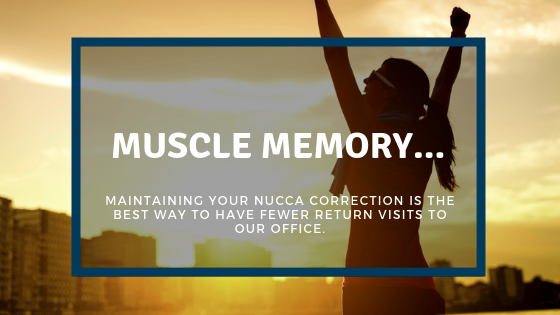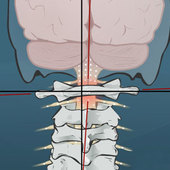
Many patients presenting to our clinic relate how their actual injury occurred years before. In most cases, these patients’ bodies have adapted to their new asymmetrical position long before they see us. For patients to sustainably recover from difficult neck injuries, we need to understand muscle memory and make it work for us.
As NUCCA chiropractors, we want you to enjoy life more, need us less, and send us your friends and family. Maintaining your NUCCA correction is the best way to have fewer return visits to our office, reduce your health care expenses, and be able to get on with your life. Perhaps you’ve already heard the term muscle memory, but if you’re like most people, you might not really understand it.
One of the most frustrating things for patients, and NUCCA chiropractors alike, is when patients aren’t able to hold their spinal correction. For you as a patient, this often means more return visits to manage your health issues. For NUCCA chiropractors, it tells us that you don’t yet have the physical ability to handle the stressors of life without ‘blowing the fuse’.
Let’s take a few minutes to help you understand muscle memory so you can become less reliant on us.
Dr. Jeff Scholten
NUCCA Chiropractor
The Vital Posture™ Clinic
Calgary, Canada
How to harness the power of muscle memory
During the initial consultation for their neck injuries, most patients tell me that they would like a more sustainable solution to their problem. We want to help you be less dependent on us over time; harnessing your muscle memory will optimize recovery from a neck injury. Before you can understand how muscle memory works, we have to go back to school for a quick muscle tutorial.
There are three basic kinds of muscle contractions:
- Reflexive (Isometric)
- Active overuse (Concentric Isotonic)
- Habitual (Eccentric Isotonic)
Reflexive contractions respond and support something else that is happening in your body, like your opposite calf contracting when you reach for something on an high shelf. Active overuse muscle contractions occur with any physical activity beyond your normal, such as the tight back and sore legs you feel after returning to a sport after many years. When a muscle is held at a certain position for an extended period of time, it slowly molds itself to that new length (shorter or longer)—this is often called muscle memory and is due to habitual contractions.
The good news is that this adaptation to muscle length is a dual trait, and muscles can habitually remodel to support an increased or reduced distance across joints; it takes time, but it is predictable. In the case of your NUCCA adjustment, our clinical experience and training in muscle physiology have helped us understand that it typically takes approximately 6-10 months for your muscles to support your new, more appropriate, postural position. At this point, a switch occurs in which muscles stop tending to pull you towards asymmetrical posture and instead start pulling you towards symmetrical posture. The only requirement for effective muscular remodeling is that the majority of time is spent in your new, correctly aligned position.
True recovery happens when you need us less!
Ultimately, our current health status is the sum total of the constructive (adaptive) and destructive (maladaptive) forces. A major maladaptive stress that we can influence is the muscle memory that may be supporting your joints in an incorrect position.
Unfortunately, when you’ve injured your neck it will never return to its uninjured state, as ligaments have been damaged to various degrees. Luckily, this doesn’t mean this injury needs to get in the way of doing the things you want or having a full and enjoyable life. The better you hold your alignment, the shorter time this recovery takes—making muscle memory work for you. Stretching during the initial trial period of care supports your alignment by enhancing the elastic nature of your muscles and thus mitigating the negative influence of maladaptive muscle memory.
When you begin care in our office, we typically check you weekly to minimize the chances of a relapse to your misaligned position. As you make the transition from your initial trial period of care to recovery care, it is important to return within a few days of losing your alignment to optimize recovery speed. After recovery is complete (meaning muscle memory has had a chance to become adaptive), we recommend giving your body a few days to work towards reducing your imbalance on its own before returning for a check-up.
Trust us with your difficult neck injury
At The Vital Posture™ Clinic, we treat imbalances in the neck that, if left untreated, can result in neck pain and neck discomfort. Although neck pain specialists don’t exist in Canada yet, there are people that have different amounts of knowledge regarding diagnosing neck problems and treating neck pain. Our focus is the neck; our intervention starts with NUCCA procedures and is augmented by our advanced post-graduate training in Pain Management and Advanced diagnostic imaging (such as MRI and CBCT), and our diplomate training in other less common chiropractic neck interventions like Blair, Knee Chest, HIO/Toggle, & Orthospinology techniques.
When you have a complicated neck issue that isn’t responding to conservative care or isn’t stabilizing as well as you would like, let us help you try to find sustainable relief from your injury.



